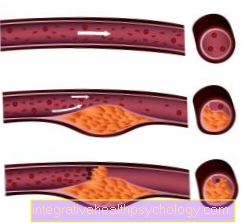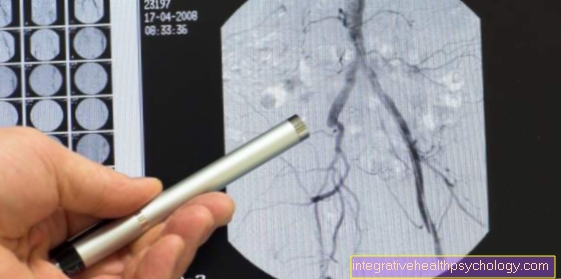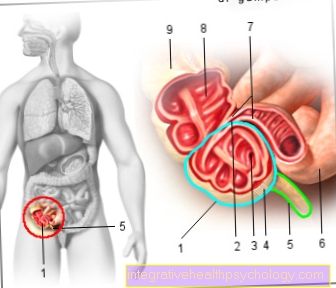Angina causes
How does angina develop?
Angina pectoris is the most intense pain behind the breastbone (retrosternal pain). This pain can radiate into various parts of the body. Angina pectoris is caused by hardening of the arteries or so-called arteriosclerosis. The causes of hardening of the arteries include increased blood lipids, high blood pressure or diabetes mellitus.
Risk factors for vascular calcification include smoking, being overweight, lack of exercise and age.

Causes of Angina Pectoris
Angina pectoris can be caused by different causes. These include:
- Coronary heart disease (CHD)
- Psychosomatic causes (depression, stress, pessimistic mood, etc.)
- High blood pressure (arterial hypertension)
- Diabetes mellitus
- cold
- Obesity
- Sedentary lifestyle
- poor diet
- Smoking as a cause
- Heart valve diseases
- Anemia (anemia)
Coronary artery disease as a cause
Coronary artery disease is by far the most common cause of angina pectoris (AP). Atherosclerotic changes occur in the area of the coronary arteries. These include calcification and hardening of the vessel walls as well as the deposition of so-called atherosclerosis plaques within the vessel. As a result, there is a reduced blood flow to the heart muscles due to the reduced diameter of the vessels.
As a result, the heart muscle cells receive less oxygen from the blood, especially when they are exerted, which causes chest pain or tightness in the chest (angina pectoris).
There are numerous risk factors for the development of coronary artery disease. These include diabetes mellitus, smoking, high blood pressure, obesity, increased fat levels (hyperlipoproteinemia) and old age.
Read more on the topic: Coronary heart disease
Stress as a cause
A cause for the development of angina pectoris that has so far only been little investigated is chronic stress. This is primarily a so-called negative stress that occurs in combination with frustration.
When the body feels very stressed, it releases more of the stress hormone cortisol from the adrenal cortex. This has numerous functions in the body. In addition to an increase in blood pressure, it also leads to the release of vascular-damaging molecules.
An already existing coronary artery disease can be aggravated by the increase in blood pressure and vascular damage in the area of the coronary arteries. As a result, the symptoms of angina pectoris can occur.
Psychological factors as the cause
Other psychological factors that have been examined in numerous studies over the past few years also have an effect similar to stress. Above all, depression, a pessimistic mood and sleep disorders had effects on various organ functions. Among other things, the blood flow to the heart was affected.
In the case of depression, for example, the risk of a heart attack increased by a factor of 2.5. The reduced release of the happiness hormone (serotonin) leads to an increased formation of blood platelets (thrombocytes) in the body. As a result, there is an increased risk of the formation of blood clots (thrombi), which can be deposited within the small coronary vessels. In the case of an already existing coronary heart disease, this additional obstruction of the vessel can then lead to acute angina pectoris.
For this reason, the psychological component should always be taken into account in the treatment of angina pectoris and, if necessary, treated with the help of psychotherapy or drug therapy with psychotropic drugs.
Cold as the cause
As studies have shown, there is an increased incidence of angina pectoris complaints, especially during the winter months.
Especially at sub-zero temperatures, the cold causes the vessels to contract.
While this phenomenon was already known in the hands, this mechanism was also evident in the vessels of the heart that are close to the surface. Because of the narrow vessels, the heart has to pump against greater resistance and therefore needs more oxygen. As a result, the heart becomes overburdened, especially in the case of an already existing coronary heart disease. The heart muscle cells can therefore no longer be adequately supplied with oxygen. The patient feels chest pain (angina pectoris) for this reason.
Diabetes mellitus as a cause
Diabetes mellitus is a frequent risk factor for the development of coronary heart disease. The chronically increased blood sugar level causes damage to the inner vessel walls (endothelium) due to the adhesion of the sugar molecules to various proteins and lipids in the vessel walls.
In addition, the sugar molecules react with cholesterol molecules, as a result of which they can be deposited within the vessel walls and promote the development of hardening of the arteries. As a result, multiple vascular damage occurs in the body.
Among other things, this also affects the coronary arteries, which can restrict the blood flow to the heart muscle cells. As a result, the risk of developing angina pectoris is increased.
Smoking as a cause
Smoking is another risk factor for developing coronary heart disease. The substances found in cigarette smoke (especially carbon monoxide and nicotine) have numerous effects on the arterial vessels.
The nicotine found in cigarettes increases blood pressure by hardening the vessel walls and narrowing the vessels. This mainly affects the small vessels (including the coronary arteries).
In addition, nicotine can lead to changes in blood clotting in the long term, which makes the blood more fluid and encourages the formation of blood clots.
In the human body, carbon monoxide mainly accumulates in the red blood cells (erythrocytes). There it means that less oxygen can be transported and released to the cells of the body. As a result, oxygen deficiency symptoms occur in the heart muscle cells, which manifest themselves as angina pectoris complaints
In addition, smoking promotes fat metabolism disorders, which are responsible for the development of atherosclerosis.
Overweight as the cause
Morbid overweight (obesity) is also a risk factor for the development of coronary heart disease.
Abdominal obesity, which is dominated by the trunk, is particularly affected.
Numerous messenger substances are released from the adipose tissue, which promote the development of diabetes mellitus, arterial hypertension and atherosclerosis. As a result, there are vascular changes, including in the area of the coronary arteries, which promote the development of angina pectoris.
Lack of exercise as the cause
Regular physical activity is known to be a protective factor for the development of cardiovascular diseases. The four largest risk factors of coronary heart disease (diabetes mellitus, high blood pressure, lipid metabolism disorders, obesity) arise, especially when there is a lack of exercise.
Light endurance activities (such as cycling, jogging, swimming) can already reduce the risk of coronary artery disease. Physical activity of at least 20-30 minutes, performed 4-5 times a week, is recommended. This leads to better blood flow to the heart muscle and a reduction in the above-mentioned risk factors for CHD.
Bad diet as the cause
A poor diet over a long period of time also increases the risk of developing coronary artery disease with angina pectoris symptoms.
Attention should be paid to a low-fat diet and regular and abundant consumption of fish products, whole grain products, and fruit and vegetables.
Above all, saturated animal fats (e.g. meat, sausage and dairy products) lead to an accumulation of fats (including cholesterol) in the blood and thus lead to an increased risk of developing atherosclerosis.
"Age" as the cause
Another risk factor for the development of coronary heart disease is age. However, this must always be assessed taking the other risk factors into account.
Accordingly, there is a clear increase in the risk of atherosclerotic changes that can lead to coronary artery disease in male patients over 45 years of age and in female patients over 55 years of age.
Women show a lower risk of developing coronary heart disease due to the protective effect of the female sex hormones (mainly through estrogen).
Stable angina pectoris
Stable angina is characterized by the fact that it occurs repetitively and behaves similarly each time it occurs.
As a rule, this form of angina occurs especially under physical burden on. The severity of the angina pectoris depends on the intensity of the physical exertion at which the symptoms occur.
Unstable angina pectoris

The first appearance of angina pectoris is always considered unstable angina pectoris.
In addition, increasing severity of angina pectoris is said to be unstable.
The unstable angina pectoris is part of the acute coronary syndrome. Acute coronary syndrome is a disease of the heart vessels that supply the heart muscle with oxygen.
In the course of arteriosclerosis, these vessels become blocked.
When the blood vessels are blocked, the heart muscle is insufficiently supplied with oxygen. If the vessel becomes completely blocked, it is a heart attack.
Since the administration of nitroglycerin leads to a widening of the vessels, this drug can easily achieve a residual supply of the affected heart muscle area with oxygen in the event of an attack of angina pectoris. A.
The cause of the pain is the insufficient supply of the heart muscle with oxygen. If the angina pectoris occurs consistently only during exercise, as in the stable form, one of the coronary arteries is very likely only partially blocked, so that an adequate supply of oxygen is guaranteed under normal circumstances.
If the patient is now stressed, the supply is no longer sufficient and pain occurs.
As soon as the stress on the heart muscle has ended, the supply is sufficient again and the pain subsides. In the event of a heart attack, the heart muscles behind the closed vessel can no longer be supplied and, without adequate supply, the heart muscle cells can die.
Prinzmetal's angina
This form of angina pectoris is a special form.
Similar to unstable angina pectoris, there is also a change in the EKG, however, these changes are in contrast to the unstable angina pectoris reversible.
The affected patients very often have constrictions Coronary arteries. In the area of these constrictions (Stenoses) it can then become a spasm of the coronary arteries.
Since this can also lead to a complete constriction, the heart muscle area behind it is less supplied with oxygen for the period of the vascular spasm, and the pain of angina pectoris occurs.
The spasm in the vessels can through cold or Cigarette smoke to be triggered. It is typical for those affected that they feel the pain when they leave a house, for example in winter.
Walking-through angina
This type of angina pectoris is a period of pain in the chest that is associated with burden starts and then stops by itself.
The body takes over the therapy of the symptoms itself.
First of all, the narrowed vessels lead to the typical pain caused by the Lack of oxygen supply.
But then the body itself releases messenger substances, which lead to a widening of the vessels so that the affected heart muscle area receives enough oxygen again.
In this way, the body supplies itself with a kind of nitroglycerin. As soon as there are enough messenger substances to widen the coronary arteries, the pain subsides despite the strain.
Nevertheless, affected patients should consult a doctor regularly, as they, like patients with Printmetal's angina, are at an increased risk for a acute coronary syndrome wear.
Prevention
Since the cause of acute angina pectoris is usually constipation constricted vessels it is important to expose the vessels to as few damaging influences as possible.
It is very important that the Blood lipid levels are in the normal range. This can be achieved through a low-fat diet or through a Mediterranean diet. Another very vascular damaging factor is smoking.
Even those who have smoked for years can lower their risk of the complications of smoking the sooner they begin to give up smoking. Of course, you cannot reduce your risk to that of a non-smoker, but an improvement can be achieved by eliminating further damage.
























.jpg)



